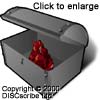
|
The Heart of Robert the Bruce
The removal of the heart and its separate placement was a custom of the aristocracy and royalty, but for one to ask a warrior to carry it into battle was new. On June 7, 1329, Robert the Bruce passed away. As ordered, his heart was removed and his body placed at Dunfermline, alongside the bodies of many a Scottish King.
There are several versions to the story as far as the type of casket the heart was actually placed in. In one story, the casket is made of silver, in another, gold. In the Chronicles of Scotland, Hector Boece states that:
The entourage landed in Spain and soon arrived at the camp of King Alfonso XI of Castile. Alfonso was engaged in battle with the current Governor of Grenada, Osmyn, a Moor, and his numerous reinforcements from Morocco. Sir James of Douglas delivered Edward III's letter of commendation, and then considered the situation. It was decided that the cause of King Alfonso was just and fit with the mission of the King's Heart. So the group of crusaders joined in the efforts against the Moors.
Sir James Douglas was given the command of a division of the Christian army, and on the 25th of March 1330 went into his first battle in Spain at Tebas de Ardales. Somehow during the course of the actual battle, the Scots found themselves cut off from the main van of the friendly force. Moors surrounded them and many in the party were slain. It is said that just before his death Sir James Douglas tore the Heart of Bruce from around his neck and flung it forward against the enemy, shouting and following it into battle. In any case, his duty was performed to his King, as the veteran of many battles in the British Isles died in this first battle of Spain, near Andalusia. Sir William Sinclair, Robert and Walter Logan, and many other companions fell with him.
The next day their bodies along with the heart of Bruce were recovered where they had fallen. Sir James Douglas was found with five mortal wounds and a ring of dead Moors lying around him. He had died valiantly in the service of his dead King.
The bodies of the fallen and the Heart of Bruce were returned to Scotland. King David, son of Robert the Bruce, desired that the heart be interred at Melrose Abbey, and it was so placed. The body of Sir James Douglas was placed at St. Bride's Church in Douglasdale.
In 1921 excavations at Melrose Abbey uncovered a small leaden casket that was formed in a cone shape. As there are no other records of a heart being buried at Melrose abbey, it is assumed to be that of Robert the Bruce. The small casket was reburied with a copper tag stating: "The enclosed leaden casket containing a heart was found beneath Chapter House floor, March 1921, by His Majesty's Office of Works". Later, in 1996, the casket was again removed and examined. It was reburied on the 22nd of June 1998.
There is no greater story of chivalry than the story of the Heart of Bruce. The Douglas family to this day carries a Bloody Heart surmounted by the Crown in their armorial bearings. A similar distinction is borne by the Lockhart family, which are the descendants of Sir Simon of Lee, who is said to have carried the heart back to Scotland. Their arms carry the symbol of heart inside a fetterlock.
by BW, February 2000
Suggested Reading:
Robert Bruce, by G.W.S. Barrow, Eyre & Spottiswoode, 1965
Links:
Melrose Abbey and the mystery of Bruce's Heart
Britanica.com-Consolidation of Power
|
Thursday, December 26th, 2019
Attention visitors: Tartans.com is back. Please note that this is a snapshot of the site as it existed nearly 20 years ago and you may encounter broken links; we are still combing through the site and correcting those as we find them. Please also note that some sections are currently not functional, primarily the discussion forums/clan chat boards.
|
** HOME - First Time Visitors - Glossary - - Contact Us ** Awards | Bibliography | Clan Calendar | Clan Chat | Clan Finder | History | Famous Scots | Genealogy | Great Hall of the Clans | Links | News and Features | Scots on the Net | Search | Site Map The Gathering of the Clans
Copyright 1995- Tartans.com - All Rights Reserved. |


